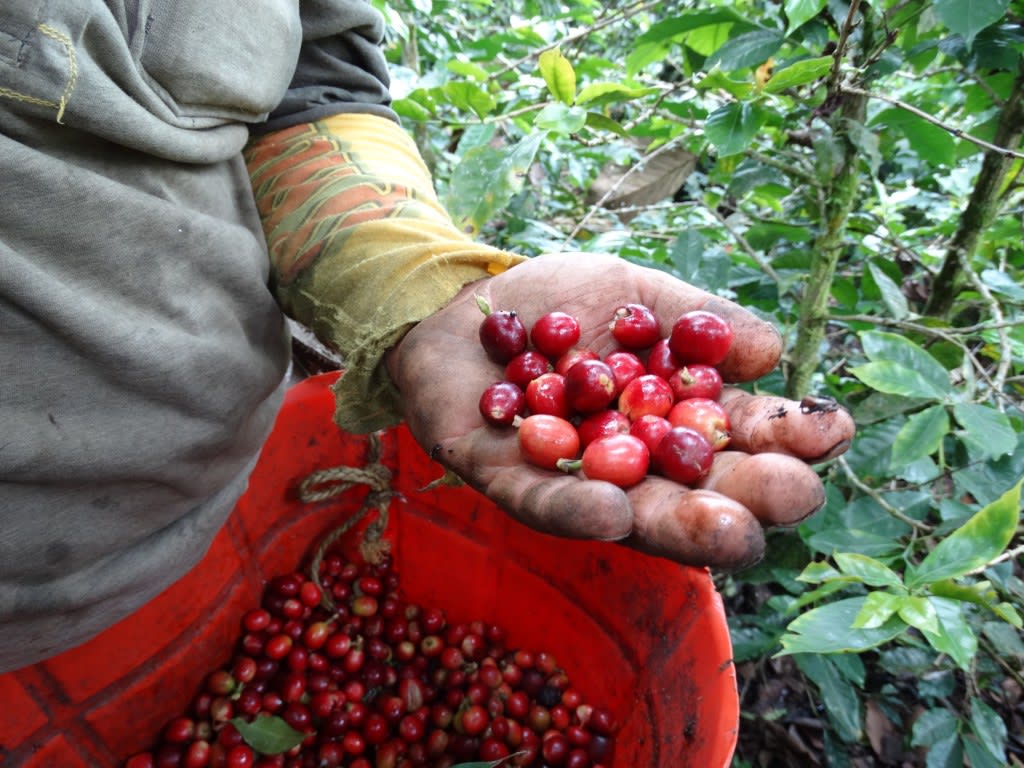Robsta and Manning are fighting for headlines, and Arabica says he wants to get involved.

Professional coffee knowledge exchange more coffee bean information please follow the coffee workshop (Wechat official account cafe_style)
No matter what kind of beans, the lighter the roasting, the more sour (this is related to the production of acetic acid during coffee roasting, which is a volatile organic acid, so the longer the roasting, the more volatile the acetic acid, the less obvious the acidity). From this we can see that Yega Xuefei and Mantenin, which are bought on the market, must be Yega Xuefei and Mantenin.
Coffee beans are the seeds of Coffea (Rubiaceae). They are covered with brightly colored berries and most of the raw beans are bluish brown. They have to go through complicated baking before they can become the raw materials of coffee beverages.
Generally speaking, there are several varieties of Rubiaceae coffee plants that can be cultivated to produce coffee beans, but two of them basically account for all the coffee production in the world.
Small fruit coffee, commonly known as Arabica coffee (Coffea Arabica), accounts for more than 70% of the world's coffee production.
The other is medium fruit coffee (Coffea Canephora), which is also known as Robusta because of its most famous variety.
There is also a large fruit coffee (Coffea Liberica), also known as Liberian coffee, whose fruit is twice as large as small fruit coffee and has a smaller market share.
In terms of ingredients alone, Arabica coffee has a low caffeine content, with a ratio of about 0.9% to 1.2%. It is rich in fat and sugar, so it has a soft, non-irritating, fresh and sweet taste, sometimes with a refreshing and pleasant sour taste. Favored by the vast majority of coffee lovers.
In addition, due to the different contents of some special chemical components, Arabica coffee has weak insect resistance and high altitude, and the result is really slow, while Robusta coffee is just the opposite. As a result, Arabica is mostly used to make fresh coffee, and a large amount of robusta coffee has become the raw material of instant coffee.
Arabica coffee is indeed more expensive in terms of price alone, and its average price is 1.5 to 2 times higher than Robusta coffee. But everything is not absolute, high-quality robusta coffee is definitely better than mediocre Arabica coffee.
In recent years, coffee farmers in Vietnam and other places have tried to improve the planting height of Robusta coffee, remove the miscellaneous flavor from the fruit, and cultivate high-quality medium-fruit coffee.
The famous Mantenin Coffee is Asian beans, which has a high Body. In addition, the flavor of Mantenin Coffee beans is characterized by herbal flavor. The general baker's method of baking is medium-deep baking to pursue the mellow thickness of Asian beans.
The three native species are Arabica, Robusta and Liberika (Liberika). Arabica ranks first in production, accounting for about 70% of the world's coffee production. There are bourbon, Tibica and other sub-varieties. Robusta accounts for about 25% of the world's total coffee production. Liberian cards account for only 3% of the total and are mostly grown in the Asia-Pacific region.
But in the case of the same roasting degree, it is necessary to consider the raw bean variety, size and hardness of the two coffees.
Mantening coffee, the general raw beans on the market are Tibica strips. And the peculiar raw bean treatment of Manning Coffee peeling wet hair will make the raw beans that are already classified as soybeans have a higher moisture content and are more resistant to drying.
Robusta has also made some contributions to the research and development of new varieties of coffee. Although Arabica is rich in aroma and delicate and changeable taste, it is not resistant to drought and waterlogging, its disease resistance is weak, and its yield is lower than that of Robusta. In order to improve the disease resistance and yield of a variety, Arabica and Robsta will be crossed first and then backcrossed, and genes will be selected to pursue new varieties with high quality flavor, strong disease resistance and high yield.
Coffee has a varied and broad potential flavor. Arabica coffee produced in different regions, different elevations and different climates usually has its own characteristics and can show a completely different flavor. "Arabica" coffee smells like grass when it is not roasted. After proper roasting, it shows "fruity" (medium-light roasting) and "caramel sweetness" (deep roasting). Generally speaking, it has a better aroma and flavor than Robusta beans. It makes it the only coffee among these original species that can be drunk directly and alone, and can be used as a single product or as an Italian blend of coffee.
Important Notice :
前街咖啡 FrontStreet Coffee has moved to new addredd:
FrontStreet Coffee Address: 315,Donghua East Road,GuangZhou
Tel:020 38364473
- Prev

I can't afford to drink rose summer, so Yega can afford it, right?
Professional coffee knowledge exchange more coffee bean information please pay attention to the coffee workshop (Wechat official account cafe_style) Ruixia this bean if there is a problem in roasting or brewing, it will taste like Yega snow coffee. And compare the blue standard Rose Xia with Yega, in fact, it is a bit of a "Tianji horse racing" feeling. Panama is the southernmost country in Central America.
- Next

The difference between fine coffee beans and commercial coffee beans. Why can boutique beans be sold
Professional coffee knowledge exchange more coffee bean information please follow the coffee workshop (Wechat official account cafe_style) what makes boutique coffee so special? We know that the quality of boutique coffee is much better than commercial beans, but why? Does it mean that the coffee fruit already has these favorite flavors and characteristics when it is picked from the tree? If only it were that simple! Follow
Related
- Guji coffee producing area of Guji, Ethiopia: Humbela, Shakiso, Wulaga
- What is the most expensive variety of Qiloso in BOP multi-variety group?
- How to store the coffee beans bought home?
- Why are Yemeni coffee beans so rare now?
- Ethiopian Sidamo all Red Fruit Sun Sun Santa Vini Coffee beans
- SOE is mostly sour? What does it mean? Is it a single bean? what's the difference between it and Italian blending?
- Is Italian coffee beans suitable for making hand-brewed coffee?
- How to choose coffee beans when making cold coffee? What kind of coffee beans are suitable for making cold coffee?
- Just entered the pit to make coffee, what kind of coffee beans should be chosen?
- Can only Japan buy real Blue Mountain Coffee? What are authentic Jamaican Blue Mountain coffee beans?

